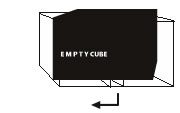RITA GASPAR VIEIRA
DECEMBER 2014

CONTACTS
ritagasparvieira@gmail.com
EXHIBITION INFORMATION
Marca D'Água #1
2014
Inkjet printing on cotton paper
43 x 29,78 cm
1/3+P.A.
Layering water
Rita Gaspar Vieira is the fourth artist to be invited to create a work specifically for e-mail diffusion by EMPTY CUBE. The work in question is a photograph from the 2014 series Marca D'Água #1. This ink-jet on cotton paper print is part of a yet unseen photographic project.
The picture Rita Gaspar Vieira presents here is a photograph documenting a wider work process, which has become more intense as the practical research for her doctoral thesis advanced. However, the limitations of her academic research did not affect the development of this photographic series, which is only a stage in that process, a process that has explored other paths, materialised in other works of a sculptural nature that have been shown in previous exhibitions.
The piece's title, 'Marca D'Água #1' [Watermark #1] references a graphic technique that was created in the 19th century as a means to certify the authenticity of a certain type of paper. This process of stamping on paper pulp leaves behind a mark that can only be seen when the paper is held against the light, as is the case of a banknote or of a sheet of Fabriano paper, the original material to use that feature. In Rita Gaspar Vieira's work, this stamping process is reversed, almost as if it were a fresco painting, in the sense that the artist manufactures the paper pulp used in these pieces herself, employing layers of cotton fibres that adhere together as a wet paste that is then made to dry. In her work, the watermark encompasses the whole process between the laying of the paste and its dried, final form, which reveals itself in layers that disclose various sediments, and consequently a chronological sequence of moments. It is a process for materialising the past, a metaphor of memory as a desideratum of the act of making under the atmospheric conditions that bring us back to earthly humanity. The angular shape of the sculpture in the photograph heightens that connection to faktura, since it explores a Constructivist legacy that allows its white, diaphanous surface to separate as a series of thin, ductile layers, disclosing two of the quadrangular plates that line the architectural space of EMPTY CUBE. The memory of her action as an artist is also the moment in which she shares the project with its hosts and viewers. In this piece, the watermark is a means to reveal and at the same time protect all the indelible and unique marks that embody the EMPTY CUBE project.
João Silvério
January 2015
